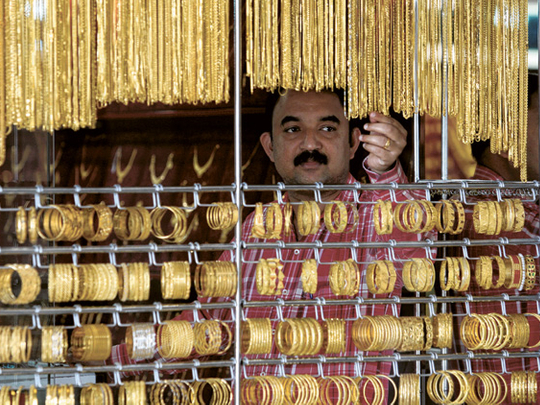
Dubai: A combination of high gold prices and increased buying during the recent festive season of Diwali will ensure Dubai's jewellers close the year on a high.
They're also starting to see more tourists spending on gold and jewellery related purchases in recent weeks.
It appears that what they cannot make up in volume, they are compensating for in terms of value. In the current market context, that's good enough, say retailers.
"According to the initial feedback, most of the major gold and jewellery chains could be looking at sales figures very similar to what was achieved last year during the same festive period," said a senior official with a leading retailer. "It could have been more, but some might have decided to wait to see if gold prices would slip from present levels."
In recent weeks, there has been a slight degree of volatility in the metal's prices. But a continued retreat, which many were betting on, is yet to materialise. This could now prompt more buying activity at the local retail level.
"Even if there is a correction in prices in coming months, the upward trend [in buying] will remain into next year as well," said Joshy Michael, the marketing manager at Malabar Gold. "The buyer knows he would definitely get an appreciation [on his current investments] when the price goes up later."
Promotions
For the recent Diwali period, the leading jewellery retailers were backing up their chances through major promotions, some of which were unprecedented in the scale of what was being offered.
"Buyers know occasions like Diwali or Akshaya Tritiya very well and they wait because there will be some promotions, gifts and new collections in the market," said Michael. High-margin jewellery makes up 80 per cent of the buying activity during Diwali, with investment products such as coins and bars making up the rest. Again, this serves the retailer well in a marketplace where volumes are falling behind.
According to the World Gold Council's latest report, tonnage demand in the Middle East is down 11 per cent to 60.4 tonnes in the third quarter, from 68 tonnes in the same period last year. But, "demand in value terms showed a solid performance, with all countries recording double-digit year-on-year gains," the report added.
For local jewellery retailers, there was another reason to cheer. The drop in volumes was the second lowest in the region, at nine per cent, after Egypt's eight per cent decline year-on-year.
Price
"Demand across the region followed a similar pattern: healthy demand in July, aided by the wedding season, coinciding with a dip in prices, followed by a weak August and September, as Ramadan and price volatility discouraged purchases," the report said.
"Across the region, the uplift in demand during July was concentrated in the 21- and 22-carat segments, while demand for lower carat jewellery remained subdued."
Again, retailers would be comfortable if that trend holds for the immediate future.
Demand in India up 36%
Demand for gold in India and China during the third quarter closely mirrored the robust health of the respective economies. Given the inherent and unyielding fascination for the metal among its consumers, India, not surprisingly, recorded the highest growth for jewellery demand with 36 per cent.
"A rise in the value of the rupee against the dollar offered Indian consumers some degree of protection from the full extent of the rise in the dollar price during the quarter," said a report by the World Gold Council.
"Given the dual purpose of Indian jewellery, as both an adornment and an investment, the rising price helped to support demand for jewellery. Furthermore, consumers have adjusted their price expectations and are anticipating yet higher prices."
Demand shot up to 184.5 tonnes, from 135.2 tonnes a year earlier. In rupee terms, demand touched a staggering 338 billion rupees (Dh27.33 billion), 67 per cent higher than the same period in 2009.
Jewellery demand across the Greater China region registered a quite favourable nine per cent year-on-year. This was predominantly concentrated in mainland China and Hong Kong, while Taiwan witnessed a drop of 13 as record prices and a sluggish retail sector left an impact.












